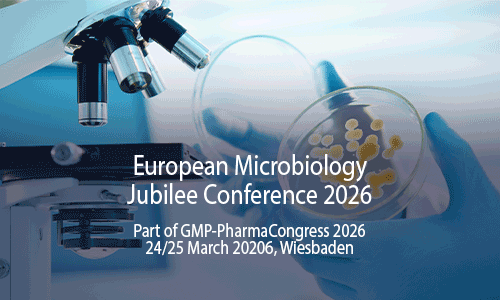Programme
Tuesday, 24 March 2026
Module 1: Phages Therapies
New Developments in Quality Control of Phage Therapy Medicinal Products (PTMPs)
Dr Oleg Kruth, PEI - German Federal Agency for Vaccines and Biomedicine
Dr Pieter-Jan Ceyssens, Sciensano
- The two recent General Chapters on PTMPs, the first one released in 2024 and the second one (on potency) planned for 2026.
- Practical experience in the quality control of therapeutics phage API, produced for magistral use in Belgium
- Phage-specific quality aspects in the production of APIs, such as induction of prophages and intrinsic genetic heterogeneity
Phage Therapy, a more Industrial View
Dr Frederique Villevie, 5 QBD-Biotech
Wednesday, 25 March 2026
Module 3: Authorities' Expectations and Pharmacopoeial Developments
FDA Microbiology Updates (Policy, Regulatory, and Inspectional Trends)
Dr Erika Pfeiler, Valsource, formerly FDA
- Get an update on the evolution of Agency policy and guidance priorities
- Learn about FDA organizational updates and what they mean for application review and facility inspection
- Explore microbiology and sterility assurance inspectional trends to proactively address compliance risks
USP Microbiological Relevant Developments
Dr Friedrich von Wintzingerode, Roche, USP Microbiology Expert Committee
EU-GMP Inspection: Inspector’s View on Microbiological Laboratory
Dr Rainer Gnibl, Government of Upper Bavaria, Germany
- General requirements
- Focus: Annex 1
- Classification of background environment for sterility-test
- Microbiological environmental monitoring
Module 2: Modern and Alternative Microbiological Methods
PDA Technical Report #33
Dr Michael Miller, Microbiology Consultants
Live Demos
- BWT
AI concepts for Environmental Monitoring trending
Emily Butterworth, Astra Zeneca
- Automated trending reports as an alternative to manual Excel spreadsheet trending
- Generative AI prompt development for large data set trending and assessment
- Concept of predictive/continuous monitoring AI tool to support Aseptic manufacturing
The Generalisation and Evolution of MAT using novel immortalized Monocyte Cells (aMylc-Z)
Kazuyo Miyzaki, Mican Technologies
- Activities for automation
- Method development to
- reduce the complexity of cell handling (no counting, no centrifugation)
- reduce the use of plastic (74% less)
- reduce the time to evaluation
Automated MAT with Technology for a robust MAT Assay
Dr Anaïs Legent, MAT Research
- Existing MAT methods – limitations in terms of speed, consistency and scalability
- Automated MAT advantages and opportunities such as improved accuracy and high throughput capacities.
- Implementation and challenges such as cost, technology integration and regulatory approvals
Module 4: Further Developments in Microbiology
Update of Microbiological general Chapters and Guidelines of the Chinese Pharmacopoeia 2025 Edition
Dr Sha Zu, Merck Life Science
- Background and overview of the Chinese Pharmacopoeia
- Update of amendments and revisions of microbiological general chapters and guidelines of the Chinese Pharmacopoeia 2025 edition
- Harmonization with international standards and regulations
- Other development trends in microbiological general chapters and guidelines of the Chinese Pharmacopoeia 2025 edition
Validation of an 8 Hour Exposure Time to UDAF of Settle Plates with a Diameter of 150 mm used in Environmental Monitoring
Dr Martin Falke, Vetter Pharma-Fertigung
- EU GMP Annex 1 (9.30) and <USP 1116> limit 90 mm settle plates under UDAF to 4–5 hours
- Data with reference strains and Vetter isolates show 150 mm plates remain viable up to 8 hours
- In very low humidity clean rooms, settle plates can be exposed up to 6 hours
- UDAF lowers plate water content to ~24%, but growth remains unaffected
- Significance: Longer exposure (up to 8 hours) reduces interventions and contamination risk
Recovery Efficiency of Contact Plates - Data from natural inoculated Surfaces
Dr Marcel Goverde, MGP
Juliane Hornung, Labor LS
- Understanding the requirements of Annex 1 §9.29: "supporting data for the recovery efficiency"
- Key insights from recovery efficiency studies: focus on contact plates
- Implications of recovery data for environmental monitoring (EM) program design and validation
The new USP chapter <1119>: Challenges in Implementation and Possible Solutions
Christine Weiß, Labor LS
- What does the new chapter demand?
- Bioburden test performance according to chapter <1119.1>
- Risk-based bioburden monitoring - how to proceed with this?
Microbiological Qualification of an autonomous Clean Room UV Robot for Disinfection
Caitlin Cooke, Astra Zeneca
- Astra Zeneca’s approach to validation (global) of the technology
- Application/integration into AZ clean rooms
- Conclusion, future and next steps - including further uses of UV light
*Programme last updated: 14.11.2025, new updates regularly
